Spatio-Temporal Validation of AIRS CO2 Observations Using GAW, HIPPO and TCCON
Abstract
1. Introduction
2. Datasets and Methods
2.1. Datasets
2.1.1. NASA’s AIRS Satellite Data
2.1.2. HIPPO Airplane Information
2.1.3. Ground-Based Data
GAW Surface Data
TCCON Column Data
2.2. Methods
2.2.1. Validation Sites and Dates
TCCON Sites vs. HIPPO Flight Paths
GAW Stations vs. TCCON Sites
2.2.2. Vertical Integration Method
Integration of HIPPO Aircraft and AIRS Retrievals
Evaluation Parameters
3. Results
3.1. Validation with TCCON and HIPPO Flight Paths
3.2. Validation with GAW and TCCON
4. Discussion
4.1. Validation Results Analysis
4.2. Spatial CO2 Distribution of AIRS
4.3. Seasonal Variation of AIRS
5. Conclusions
Author Contributions
Funding
Acknowledgments
Conflicts of Interest
References
- Solomon, S.; Qin, D.; Manning, M.; Marquis, M.; Averyt, K.; Tignor, M.M.B.; Miller, H.L., Jr.; Chen, Z.E. IPCC (Intergovernmental Panel on Climate Change), Climate Change 2007: The Physical Science Basis Contribution of Working Group I to the Fourth Assessment Report of the Intergovernmental Panel on Climate Change; Cambridge University Press: Cambridge, UK; New York, NY, USA, 2007; p. 996. [Google Scholar]
- Available online: https://climate.nasa.gov/news/2915/the-atmosphere-getting-a-handle-on-carbon-dioxide/ (accessed on 8 September 2020).
- NOAA Mauna Loa CO2 Data. Available online: http://co2now.org/Current-CO2/CO2-Now/noaa-mauna-loa-co2-data.html (accessed on 16 October 2020).
- Engelen, R.J.; Serrar, S.; Chevallier, F. Four-dimensional data assimilation of atmospheric CO2 using AIRS observations. Geophysical Research. J. Geophys. Res. Atmos. 2009, 114. [Google Scholar] [CrossRef]
- Chédin, A.; Hollingsworth, A.; Scott, N.A.; Serrar, S.; Crevoisier, C.; Armante, R. Annual and seasonal variations of atmospheric CO2, N2O and CO concentrations retrieved from NOAA/TOVS satellite observations. Geophys. Res. Lett. 2002, 29, 110–114. [Google Scholar] [CrossRef]
- Burrows, J.P.; Hölzle, E.; Goede, A.; Visser, H.; Fricke, W. SCIAMACHY—Scanning imaging absorption spectrometer for atmospheric chartography. Acta Astronaut. 1995, 35, 445–451. [Google Scholar] [CrossRef]
- Engelen, R.J.; Andersson, E.; Chevallier, F.; Hollingsworth, A.; Matricardi, M.; McNally, A.P.; Thepaut, J.; Watts, P.D. Estimating atmospheric CO2 from advanced infrared satellite radiances within an operational 4D-Var data assimilation system: Methodology and first results. J. Geophys. Res. 2004, 109. [Google Scholar] [CrossRef]
- Eldering, A.; O’Dell, C.W.; Wennberg, P.O.; Crisp, D.; Gunson, M.R.; Viatte, C.; Avis, C.; Braverman, A.; Castano, R.; Chang, A.; et al. The Orbiting Carbon Observatory-2: First 18 months of science data products. Atmos. Meas. Tech. 2017, 10, 549–563. [Google Scholar] [CrossRef]
- Eldering, A.; Wennberg, P.O.; Crisp, D.; Schimel, D.; Gunson, M.R.; Chatterjee, A.; Liu, J.; Schwandner, F.M.; Sun, Y.; O’Dell, C.W.; et al. The Orbiting Carbon Observatory-2 early science investigations of regional carbon dioxide fluxes. Science 2017, 358, eaam5745. [Google Scholar] [CrossRef] [PubMed]
- Crisp, D.; Pollock, H.R.; Rosenberg, R.; Chapsky, L.; Lee, R.A.M.; Oyafuso, F.A.; Frankenberg, C.; O’Dell, C.W.; Bruegge, C.J.; Doran, G.B.; et al. The on-orbit performance of the Orbiting Carbon Observatory-2 (OCO-2) instrument and its radiometrically calibrated products. Atmos. Meas. Tech. 2017, 10, 59–81. [Google Scholar] [CrossRef]
- Yokota, T.; Yoshida, Y.; Eguchi, N.; Ota, Y.; Tanaka, T.; Watanabe, H.; Maksyutov, S. Global Concentrations of CO2 and CH4 Retrieved from GOSAT: First Preliminary Results. SOLA 2009, 5, 160–163. [Google Scholar] [CrossRef]
- Yang, D.; Liu, Y.; Cai, Z.; Chen, X.; Yao, L.; Lu, D. First Global Carbon Dioxide Maps Produced from TanSat Measurements. Adv. Atmos. Sci. 2018, 35, 621–623. [Google Scholar] [CrossRef]
- Liu, Y.; Cai, Z.; Yang, D.; Zheng, Y.; Duan, M.; Lü, D. Effects of spectral sampling rate and range of CO2 absorption bands on XCO2 retrieval from TanSat hyperspectral spectrometer. Sci. Bull. 2014, 59, 1485–1491. [Google Scholar] [CrossRef]
- Hakkarainen, J.; Ialongo, I.; Maksyutov, S.; Crisp, D. Analysis for Four Years of Global XCO2 Anomalies as Seen by Orbiting Carbon Observatory-2. Remote Sens. 2019, 11, 850. [Google Scholar] [CrossRef]
- Zhang, M.; Zhang, X.Y.; Liu, R.X.; Hu, L.Q. A study of the validation of atmospheric CO2 from satellite hyper spectral remote sensing. Adv. Clim. Chang. Res. 2014, 5, 131–135. [Google Scholar] [CrossRef]
- Buchwitz, M.; Khlystova, I.; Schneising, O.; Bovensmann, H.; Burrows, J.P. SCIAMACHY/WFM-DOAS tropospheric CO, CH4, and CO2 scientific data products: Validation and rcent developments. In Proceedings of the Third Workshop on the Atmospheric Chemistry Validation of ENVISAT (ACVE-3), ESA/ESRIN, Frascati, Italy, 4–7 December 2006. [Google Scholar]
- Cortesi, U.; Bianco, S.D.; Gai, M.; Carli, B. Carbon dioxide retrieval from IASI measurements using the KLIMA inversion algorithm. In Proceedings of the ESA Living Planet Symposium, Bergen, Norway, 28 June–2 July 2010. [Google Scholar]
- Tadić, J.M.; Loewenstein, M.; Frankenberg, C.; Iraci, L.T.; Yates, E.L.; Gore, W.; Kuze, A. A comparison of in-situ aircraft measurements of carbon dioxide to GOSAT data measured over Railroad Valley playa. Nevada, USA. Atmos. Meas. Tech. Discuss. 2012, 5, 5641–5664. [Google Scholar] [CrossRef]
- Tanakaa, T.; Shiomia, K.; Kawakamia, S.J.; Saitoh, N.; Imasu, R.; Inoue, M.; Morino, I.; Uchino, O.; Sweeney, C.; Tans, P. Characterization and validation of CO2 and CH4 products derived from the GOSAT thermal infrared band. In Earth Observing Missions and Sensors: Development, Implementation, and Characterization II; Asia-Pacific Remote Sensing: Kyoto, Japan, 2012. [Google Scholar]
- Tadic´, J.M.; Michalak, A.M. On the effect of spatial variability and support on validation of remote sensing observations of CO2. Atmos. Environ. 2016, 132, 309–316. [Google Scholar] [CrossRef]
- Saitoh, N.; Kimoto, S.; Sugimura, R.; Imasu, R.; Kawakami, S.; Shiomi, K.; Kuze, A.; Machida, T.; Sawa, Y.; Matsueda, H. Algorithm update of the GOSAT/TANSO-FTS thermal infrared CO2 product (version 1) and validation of the UTLS CO2 data using CONTRAIL measurements. Atmos. Meas. Tech. 2016, 9, 2119–2134. [Google Scholar] [CrossRef]
- Kulawik, S.S.; O’Dell, C.; Payne, V.H.; Kuai, L.; Worden, H.M.; Biraud, S.C.; Sweeney, C.; Stephens, B.; Iraci, L.T.; Yates, E.L.; et al. Lower-tropospheric CO2 from near-infrared ACOS-GOSAT observations. Atmos. Chem. Phys. 2017, 17, 5407–5438. [Google Scholar] [CrossRef]
- Chevallier, F.; Engelen, R.J.; Peylin, P. The contribution of AIRS data to the estimation of CO2 sources and sinks. Geophys. Res. Lett. 2005, 32, 161–164. [Google Scholar] [CrossRef]
- Matsueda, H.; Inoue, H.Y.; Ishii, M. Aircraft observation of carbon dioxide at 8–13 km altitude over the western Pacific from 1993 to 1999. Tellus B Chem. Phys. Meteorol. 2002, 54, 1–21. [Google Scholar]
- Crevoisier, C.; Heilliette, S.; Che´din, A.; Serrar, S.; Armante, R.; Scott, N.A. Midtropospheric CO2 concentration retrieval from AIRS observations in the tropics. Geophys. Res. Lett. 2004, 31, L17106. [Google Scholar] [CrossRef]
- Chahine, M.; Barnet, C.; Olsen, E.T.; Chen, L.; Maddy, E. On the determination of atmospheric minor gases by the method of vanishing partial derivatives with application to CO2. Geophys. Res. Lett. 2005, 32, L22803. [Google Scholar] [CrossRef]
- Olsen, E.T.; Chahine, M.T.; Chen, L.; Jiang, X.; Pagano, T.S.; Yung, Y.L. Validation of AIRS retrievals of CO2 via comparison to in-situ measurements. In Abstract A32B-04 Presented at AGU Fall Meeting; AGU: San Francisco, CA, USA, 2008. [Google Scholar]
- Lee, S.; Im, J.; Lee, M. The spatiotemporal variations of CO2 in the Troposphere using multi-sensor Satellite Data and Aircraft Observation. In Proceedings of the 2015 IEEE International Geoscience and Remote Sensing Symposium (IGARSS), Milan, Italy, 26–31 July 2015; pp. 2214–2217. [Google Scholar]
- Maddy, E.S.; Barnet, C.D.; Goldbert, M.; Sweeney, C.; Liu, X. CO2 retrievals from the Atmospheric Infrared Sounder: Methodology and validation. J. Geophys. Res. 2008, 113. [Google Scholar] [CrossRef]
- Frankenberg, C.; Kulawik, S.S.; Wofsy, S.C.; Chevallier, F.; Daube, B.; Kort, E.A.; O’Dell, C.; Olsen, E.T.; Osterman, G. Using airborne HIAPER Pole-to-Pole Observations (HIPPO) to evaluate model and remote sensing estimates of atmospheric carbon dioxide. Atmos. Chem. Phys. 2016, 16, 7867–7878. [Google Scholar] [CrossRef]
- Zhang, X.; Bai, W.; Zhang, P. Temporal and spatial distribution of tropospheric CO2 over China based on satellite observations. IOP Conf. Ser. Earth Environ. Sci. 2019, 373. [Google Scholar] [CrossRef]
- Zhang, L.J.; Zhang, X.Y.; Jiang, H. Accuracy comparisons of AIRS, SCIAMACHY and GOSAT with ground-based data based on global CO2 concentration. Int. Conf. Geoinform. Kaifeng. 2013, 1–5. [Google Scholar] [CrossRef]
- Zhang, L.J.; Jiang, H.; Zhang, X.Y. Comparison analysis of the global carbon dioxide concentration column derived from SCIAMACHY, AIRS, and GOSAT with surface station measurements. Int. J. Remote Sens. 2015, 36, 1406–1423. [Google Scholar] [CrossRef]
- Diao, A.; Shu, J.; Song, C.; Gao, W. Global consistency check of AIRS and IASI total CO2 column concentrations using WDCGG ground-based measurements. Front. Earth Sci. 2017, 11, 1–10. [Google Scholar] [CrossRef]
- Wunch, D.; Wennberg, P.O.; Toon, G.C.; Keppel-aleks, G.; Yavin, Y.G. Emissions of greenhouse gases from a North American megacity. Geophys. Res. Lett. 2009, 35, 139–156. [Google Scholar] [CrossRef]
- Aumann, H.H.; Chahine, M.T.; Gautier, C.; Goldberg, M.D.; Kalnay, E.; McMillin, L.M.; Revercomb, H.; Rosenkranz, P.W.; Smith, W.L.; Staelin, D.H.; et al. AIRS/AMSU/HSB on the Aqua mission: Design, science objectives, data products, and processing systems. Geoscience and Remote Sensing. IEEE Trans. Geosci. Remote Sens. 2003, 41, 253–264. [Google Scholar] [CrossRef]
- Pagano, T.S.; Aumann, H.H.; Hagan, D.E.; Overoye, K. Prelaunch and In-Flight Radiometric Calibration of the Atmospheric Infrared Sounder (AIRS). IEEE Trans. Geosci. Remote Sens. 2003, 41, 265–273. [Google Scholar] [CrossRef]
- Engelen, R.J.; McNally, A.P. Estimating atmospheric CO2 from advanced infrared satellite radiances within an operational four-dimensional variational (4D-Var) data assimilation system: Results and validation. J. Geophys. Res. 2005, 110. [Google Scholar] [CrossRef]
- Chahine, M.T.; Pagano, T.S.; Aumann, H.H.; Atlas, R.; Barnet, C.; Blaisdell, J.; Chen, L.; Divakarla, M.; Fetzer, E.J.; Goldberg, M.; et al. AIRS: Improving weather forecasting and providing new data on greenhouse gases. Bull. Am. Meteorol. Soc. 2006, 87, 911–926. [Google Scholar] [CrossRef]
- Wofsy, S.C. HIAPER Pole-to-Pole Observations (HIPPO): Fine-grained, global-scale measurements of climatically important atmospheric gases and aerosols. Philos. Trans. R. Soc. A 2011, 369, 2073–2086. [Google Scholar] [CrossRef] [PubMed]
- Wang, Q.; Jacob, D.J.; Spackman, J.R.; Perring, A.E.; Schwarz, J.P.; Moteki, N.; Marais, E.A.; Ge, C.; Wang, J.; Barrett, S.R.H. Global budget and radiative forcing of black carbon aerosol: Constraints from pole-to-pole (HIPPO) observations across the Pacific. J. Geophys. Res. Atmos. 2014, 119, 195–206. [Google Scholar] [CrossRef]
- Samset, B.H.; Myhre, G.; Herber, A.; Kondo, Y.; Li, S.M.; Moteki, N.; Koike, M.; Oshima, N.; Schwarz, J.P.; Balkanski, Y.; et al. Modelled black carbon radiative forcing and atmospheric lifetime in AeroCom Phase II constrained by aircraft observations. Atmos. Chem. Phys. 2014, 14, 12465–12477. [Google Scholar] [CrossRef]
- Hatakka, J.; Aalto, T.; Aaltonen, V.; Aurela, M.; Hakola, H.; Komppula, M.; Laurila, T.; Lihavainen, H.; Paatero, J.; Salminen, K.; et al. Overview of the atmospheric research activities and results at Pallas GAW station. Boreal Environ. Res. 2003, 8, 365–383. [Google Scholar]
- Karla, T.R.; Diamonda, H.J.; Bojinskib, S.; Butlerc, J.H.; Dolmand, H.; Haeberlie, W.; Harrisonf, D.E.; Nyongg, A.; Rösnerh, S.; Seizi, G.; et al. Observation Needs for Climate Information, Prediction and Application: Capabilities of Existing and Future Observing Systems. Procedia Environ. Sci. 2010, 1, 192–205. [Google Scholar] [CrossRef]
- WMO/GAW Glossary of QA/QC-Related Terminology, WMO (2007). Available online: http://gaw.empa.ch/glossary.html (accessed on 16 August 2019).
- Wunch, D.; Toon, G.C.; Wennberg, P.O.; Wofsy, S.C.; Stephens, B.B.; Fischer, M.L.; Uchino, O.; Abshire, J.B.; Bernath, P.; Biraud, S.C.; et al. Calibration of the Total Carbon Column Observing Network using aircraft profile data. Atmos. Chem. Phys. 2010, 3, 1351–1362. [Google Scholar]
- Wunch, D.; Toon, G.C.; Blavier, J.F.L.; Washenfelder, R.A.; Notholt, J.; Connor, B.J.; Griffith, D.W.T.; Sherlock, V.; Wennberg, P.O. The Total Carbon Column Observing Network (TCCON). Philos. Trans. R. Soc. A 2011, 369, 2087–2112. [Google Scholar] [CrossRef]
- Messerschmidt, J.; Geibel, M.C.; Blumenstock, T.; Chen, H.; Deutscher, N.M.; Engel, A.; Feist, D.; Gerbig, C.; Gisi, M.; Hase, F.; et al. Calibration of TCCON column-averaged CO2: The first aircraft campaign over European TCCON sites. Atmos. Chem. Phys. 2011, 11, 10765–10777. [Google Scholar] [CrossRef]
- Total Carbon Column Observing Network (TCCON) Team. 2014 TCCON Data Release (Version GGG2014) [Data Set]. CaltechDATA. 2017. Available online: https://doi.org/10.14291/TCCON.GGG2014 (accessed on 16 August 2019).
- Keppel-Aleks, G.; Wennberg, P.O.; Schneider, T.; Honsowetz, N.Q.; Vay, S.A. Total column constraints on Northern Hemisphere carbon dioxide surface exchange. In Proceedings of the American Geophysical Union Fall Meeting, San Francisco, CA, USA, 15–19 December 2008. [Google Scholar]
- Wennberg, P.O.; Wunch, D.; Roehl, C.; Blavier, J.-F.; Toon, G.C.; Allen, N. TCCON Data from Lamont(US), Release GGG2014.R1, TCCON Data Archive, Hosted by CaltechDATA. 201. Available online: https://doi.org/10.14291/tccon.ggg2014.lamont01.R1/1255070 (accessed on 16 August 2019).
- Wennberg, P.O.; Roehl, C.M.; Wunch, D.; Toon, G.C.; Blavier, J.-F.; Washenfelder, R.; Keppel-Aleks, G.; Allen, N.T.; Ayers, J. TCCON Data from Park Falls (US), Release GGG2014.R1 (Version GGG2014.R1) [Data Set]. CaltechDATA. 2017. Available online: https://doi.org/10.14291/TCCON.GGG2014.PARKFALLS01.R1 (accessed on 16 August 2019).
- Griffith, D.W.T.; Deutscher, N.M.; Velazco, V.A.; Wennberg, P.O.; Yavin, Y.; Keppel-Aleks, G.; Washenfelder, R.A.; Toon, G.C.; Blavier, J.-F.; Paton-Walsh, C.; et al. TCCON Data from Darwin (AU), Release GGG2014.R0 (Version GGG2014.R0) [Data Set]. CaltechDATA. 2014. Available online: https://doi.org/10.14291/TCCON.GGG2014.DARWIN01.R0/1149290 (accessed on 16 August 2019).
- Notholt, J.; Warneke, T.; Petri, C.; Deutscher, N.M.; Weinzierl, C.; Palm, M.; Buschmann, M. TCCON Data from Ny Ålesund, Spitsbergen (NO), Release GGG2014.R1 (Version R1) [Data Set]. CaltechDATA. 2019. Available online: https://doi.org/10.14291/TCCON.GGG2014.NYALESUND01.R1 (accessed on 16 August 2019).
- Sussmann, R.; Rettinger, M. TCCON Data from Garmisch (DE), Release GGG2014.R2 (Version R2) [Data Set]. CaltechDATA. 2018. Available online: https://doi.org/10.14291/TCCON.GGG2014.GARMISCH01.R2 (accessed on 16 August 2019).
- Morino, I.; Matsuzaki, T.; Horikawa, M. TCCON Data from Tsukuba (JP), 125HR, Release GGG2014.R2 (Version R2) [Data Set]. CaltechDATA. 2018. Available online: https://doi.org/10.14291/TCCON.GGG2014.TSUKUBA02.R2 (accessed on 16 August 2019).
- Blumenstock, T.; Hase, F.; Schneider, M.; García, O.E.; Sepúlveda, E. TCCON Data from Izana (ES), Release GGG2014.R1 (Version R1) [Data Set]. CaltechDATA. 2017. Available online: https://doi.org/10.14291/TCCON.GGG2014.IZANA01.R1 (accessed on 16 August 2019).
- Notholt, J.; Petri, C.; Warneke, T.; Deutscher, N.M.; Palm, M.; Buschmann, M.; Weinzierl, C.; Macatangay, R.C.; Grupe, P. TCCON Data from Bremen (DE), Release GGG2014.R1 (Version R1) [Data Set]. CaltechDATA. 2019. Available online: https://doi.org/10.14291/TCCON.GGG2014.BREMEN01.R1 (accessed on 16 August 2019).
- Sherlock, V.; Connor, B.; Robinson, J.; Shiona, H.; Smale, D.; Pollard, D.F. TCCON Data from Lauder (NZ), 120HR, Release GGG2014.R0 (Version GGG2014.R0) [Data Set]. CaltechDATA. 2014. Available online: https://doi.org/10.14291/TCCON.GGG2014.LAUDER01.R0/1149293 (accessed on 16 August 2019).
- Griffith, D.W.T.; Velazco, V.A.; Deutscher, N.M.; Paton-Walsh, C.; Jones, N.B.; Wilson, S.R.; Macatangay, R.C.; Kettlewell, G.C.; Buchholz, R.R.; Riggenbach, M.O. TCCON Data from Wollongong (AU), Release GGG2014.R0 (Version GGG2014.R0) [Data Set]. CaltechDATA. 2014. Available online: https://doi.org/10.14291/TCCON.GGG2014.WOLLONGONG01.R0/1149291 (accessed on 16 August 2019).
- Rodgers, C.D.; Connor, B.J. Intercomparison of remote sounding Instruments. J. Geophys. Res. 2003, 108, 4116–4229. [Google Scholar] [CrossRef]
- Deutscher, N.; Griffith, D.W.T.; Bryant, G.W.; Wennberg, P.O.; Toon, G.C.; Washenfelder, R.A.; Keppel-Aleks, G.; Wunch, D.; Yavin, Y.; Allen, N.T.; et al. Total column CO2 measurements at Darwin, Australia—Site description and calibration against in situ aircraft profiles. Atmos. Meas. Tech. 2010, 3, 947–958. [Google Scholar] [CrossRef]
- Available online: https://tccon-wiki.caltech.edu/Main/AuxilaryData (accessed on 18 August 2019).
- Leptoukh, G.; Ouzounov, D.; Savtchenko, A.; Ahmad, S.; Lu, L.; Pollack, N.; Liu, Z.; Johnson, J.; Qin, J.; Cho, S.; et al. HDF/HDF-EOS data access, visualization and processing tools at the GES DAAC. IEEE Int. Geosci. Remote Sens. Symp. 2003, 6, 3571–3573. [Google Scholar]
- Etheridge, D.M.; Pearman, G.I.; Silva, F.D. Atmospheric trace-gas variations as revealed by air trapped in an ice core from Law Dome. Ann. Glaciol. 1988, 10, 28–33. [Google Scholar] [CrossRef][Green Version]
- Schneider, S.H. The greenhouse effect: Science and policy. Science 1989, 243, 771–781. [Google Scholar] [CrossRef]

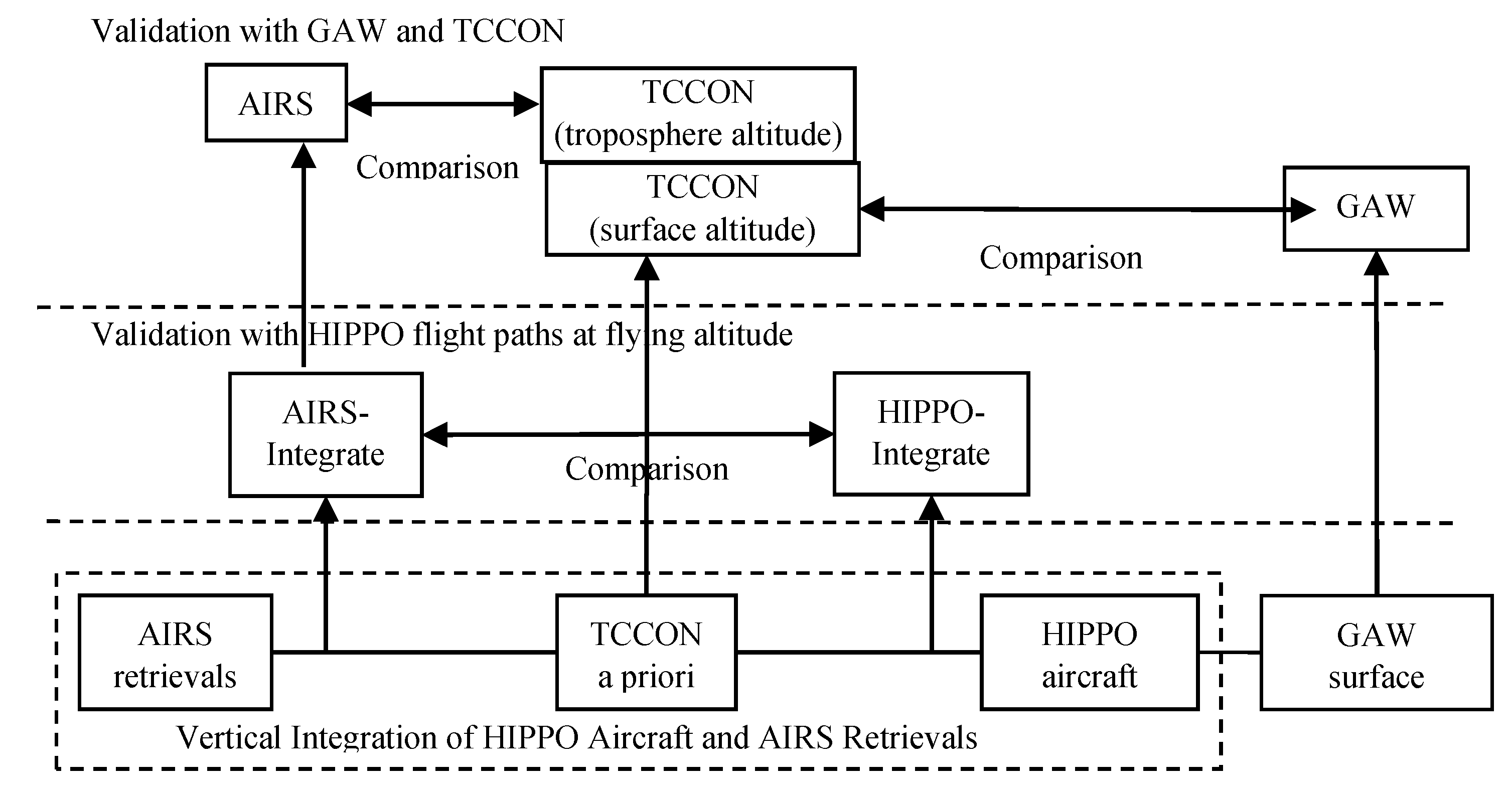
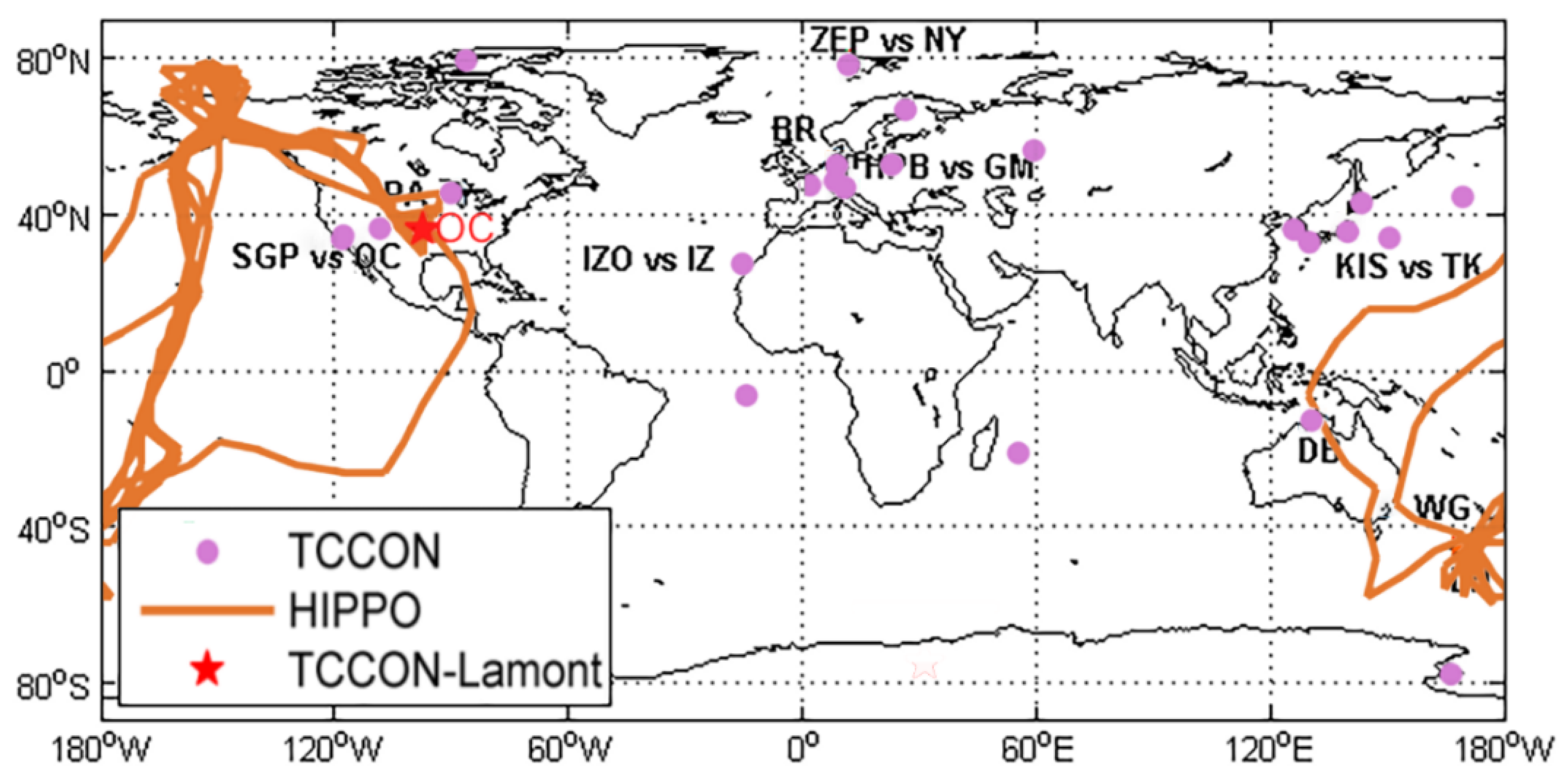
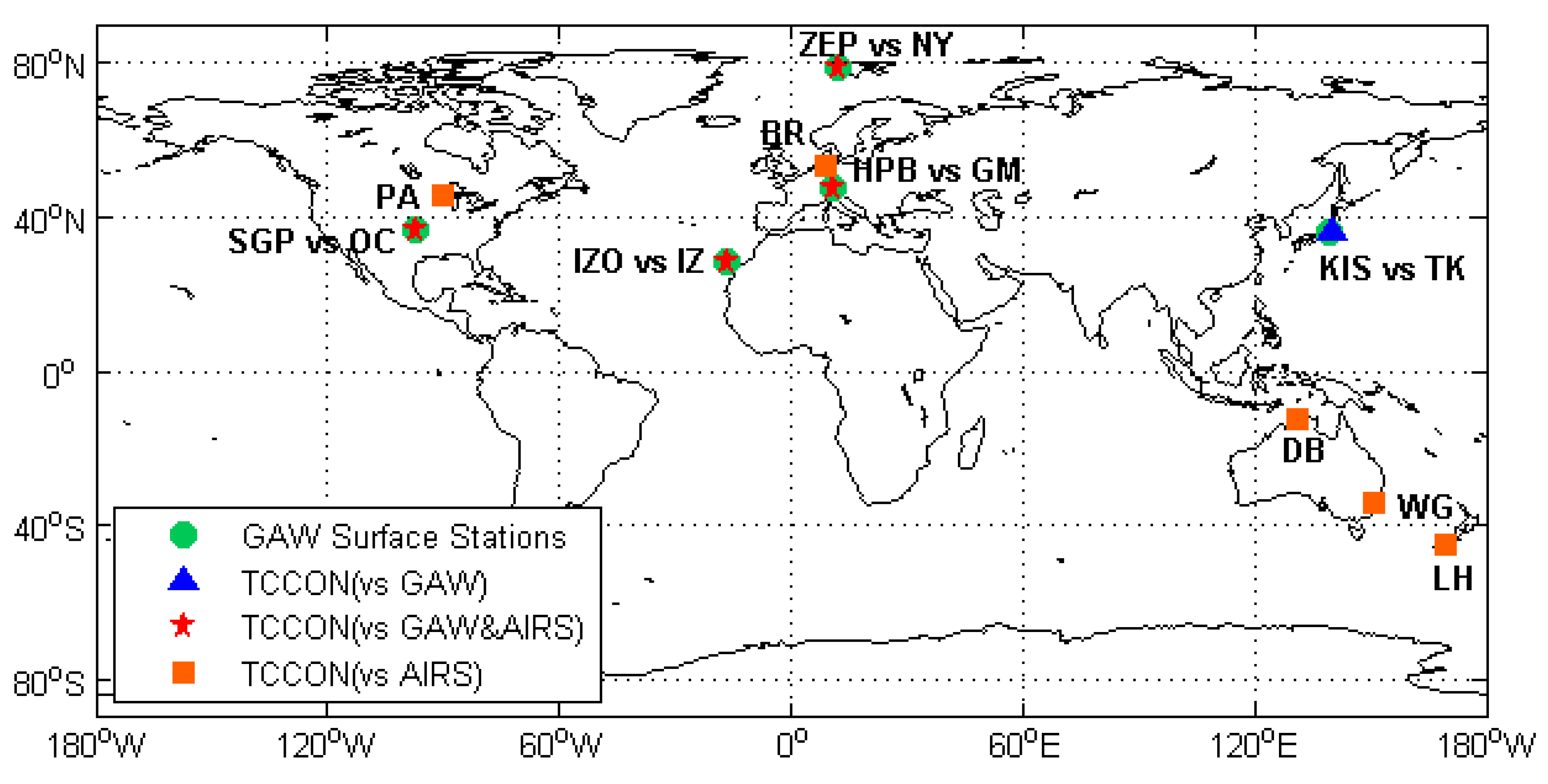
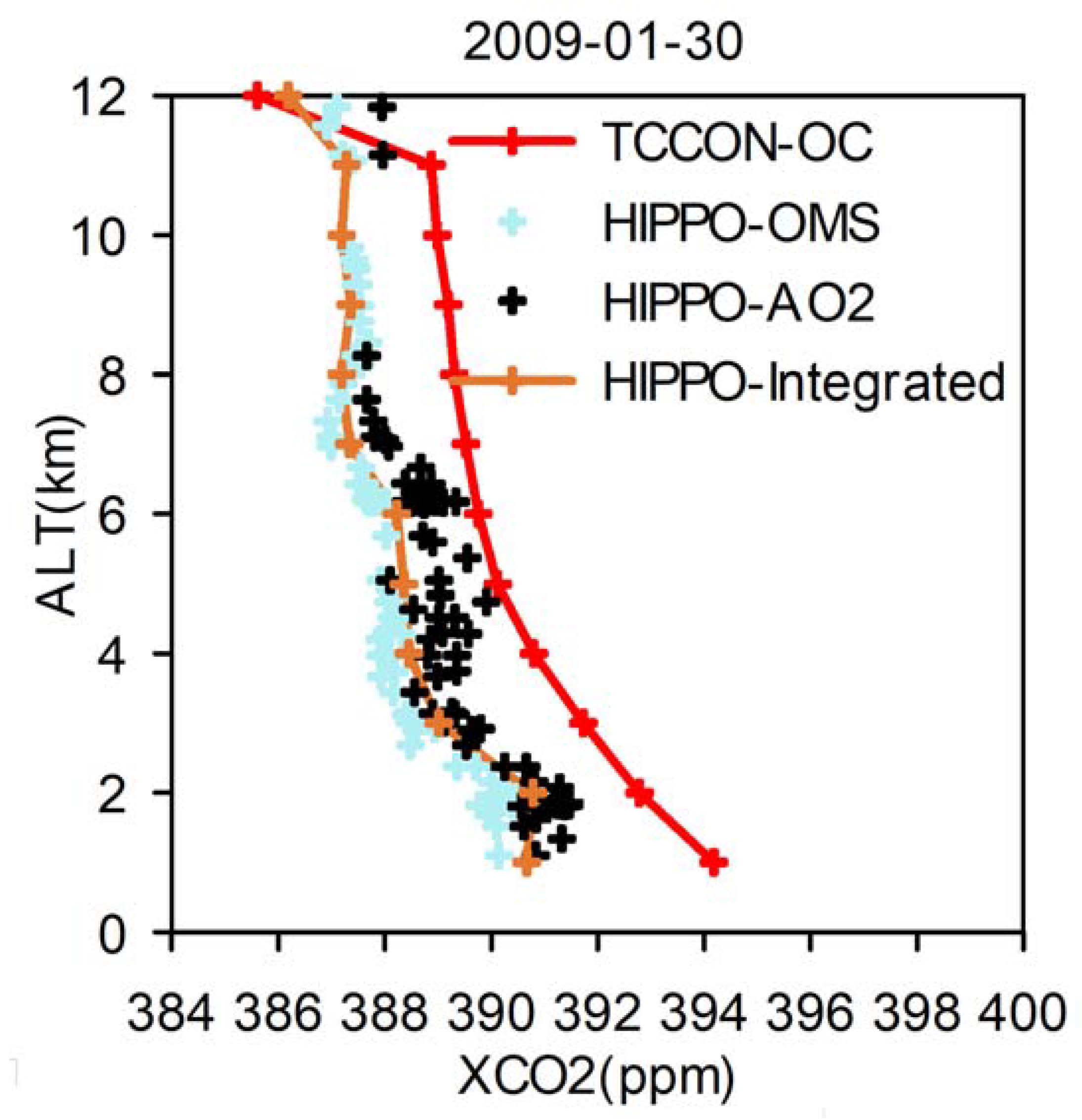


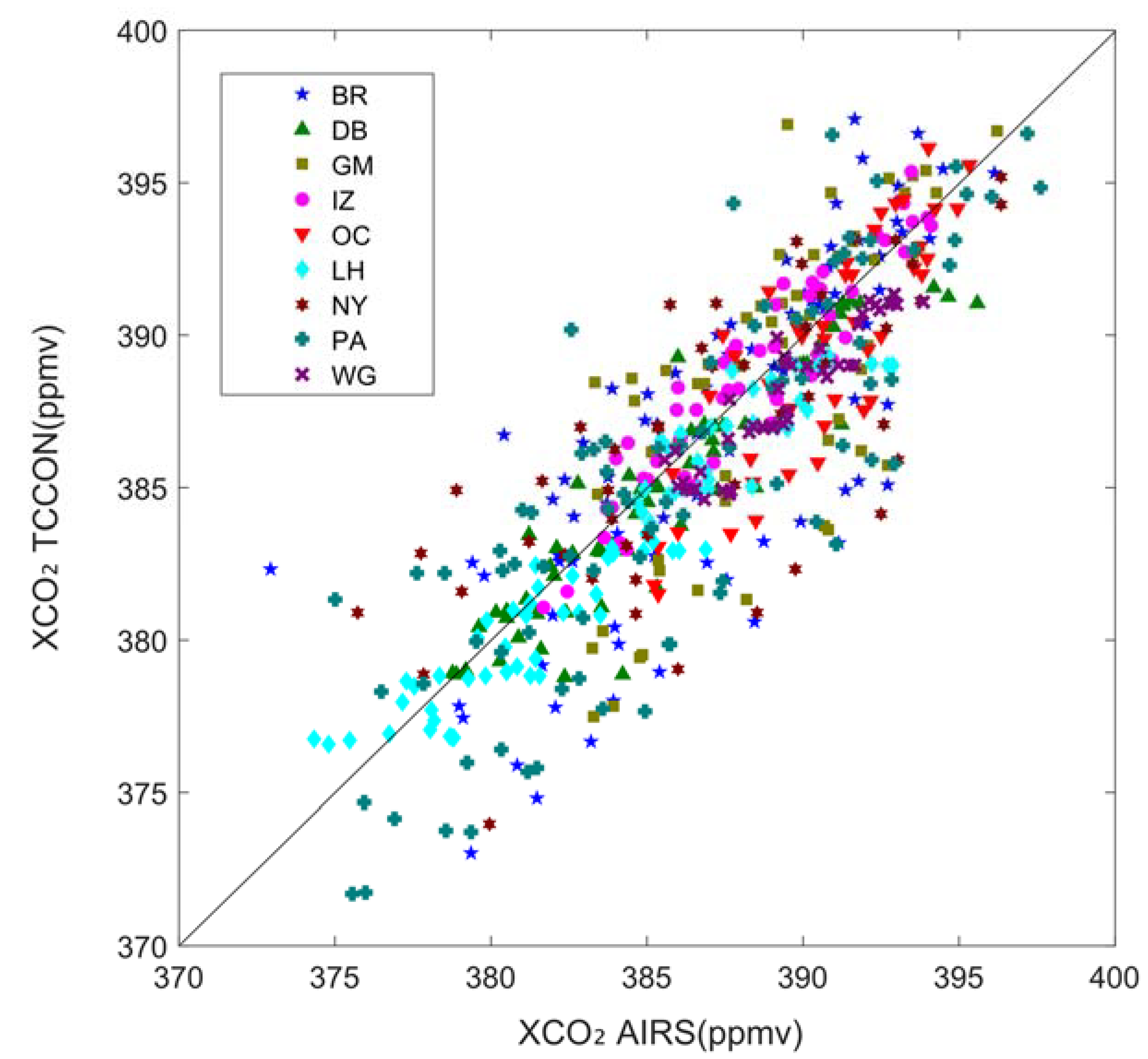

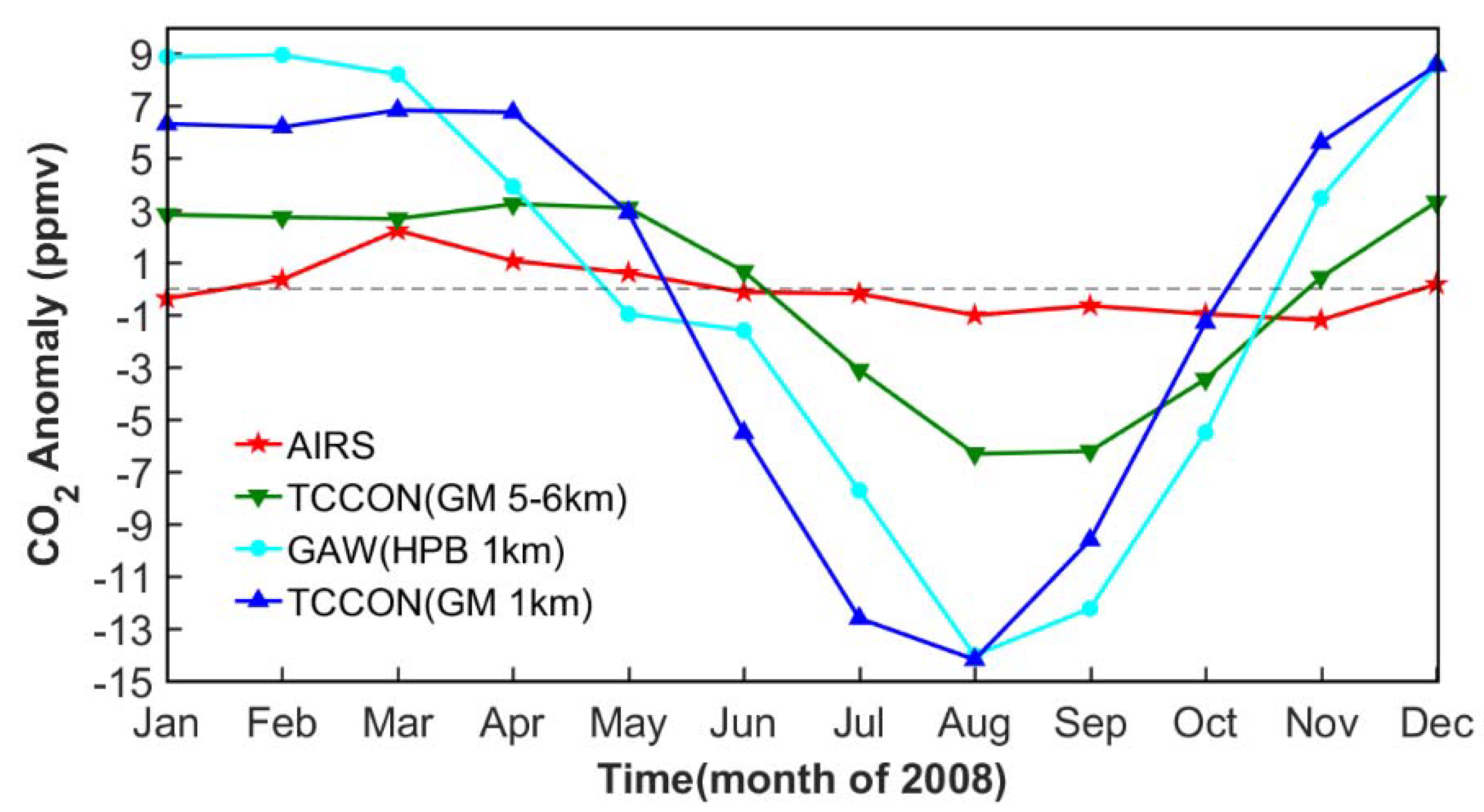
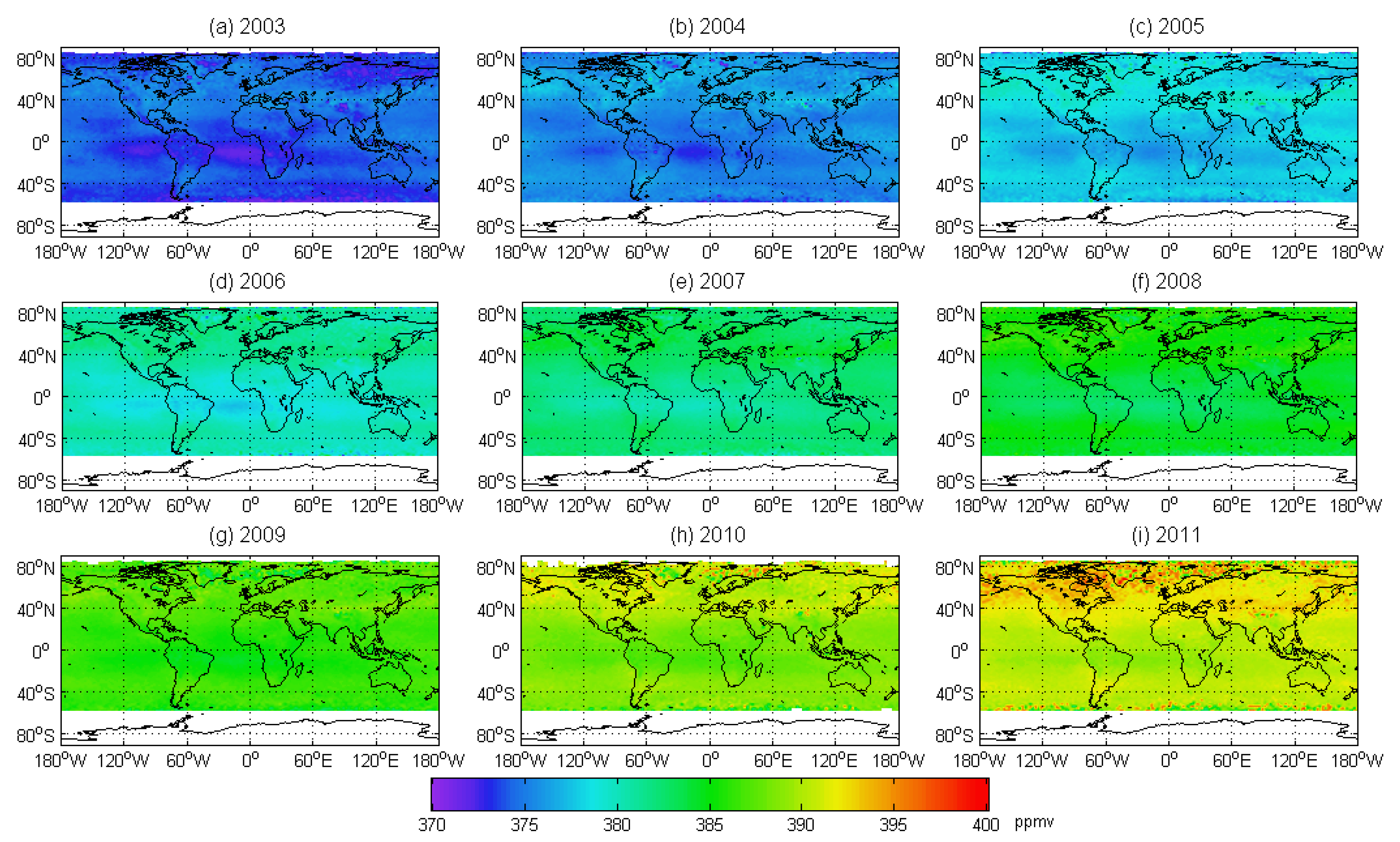

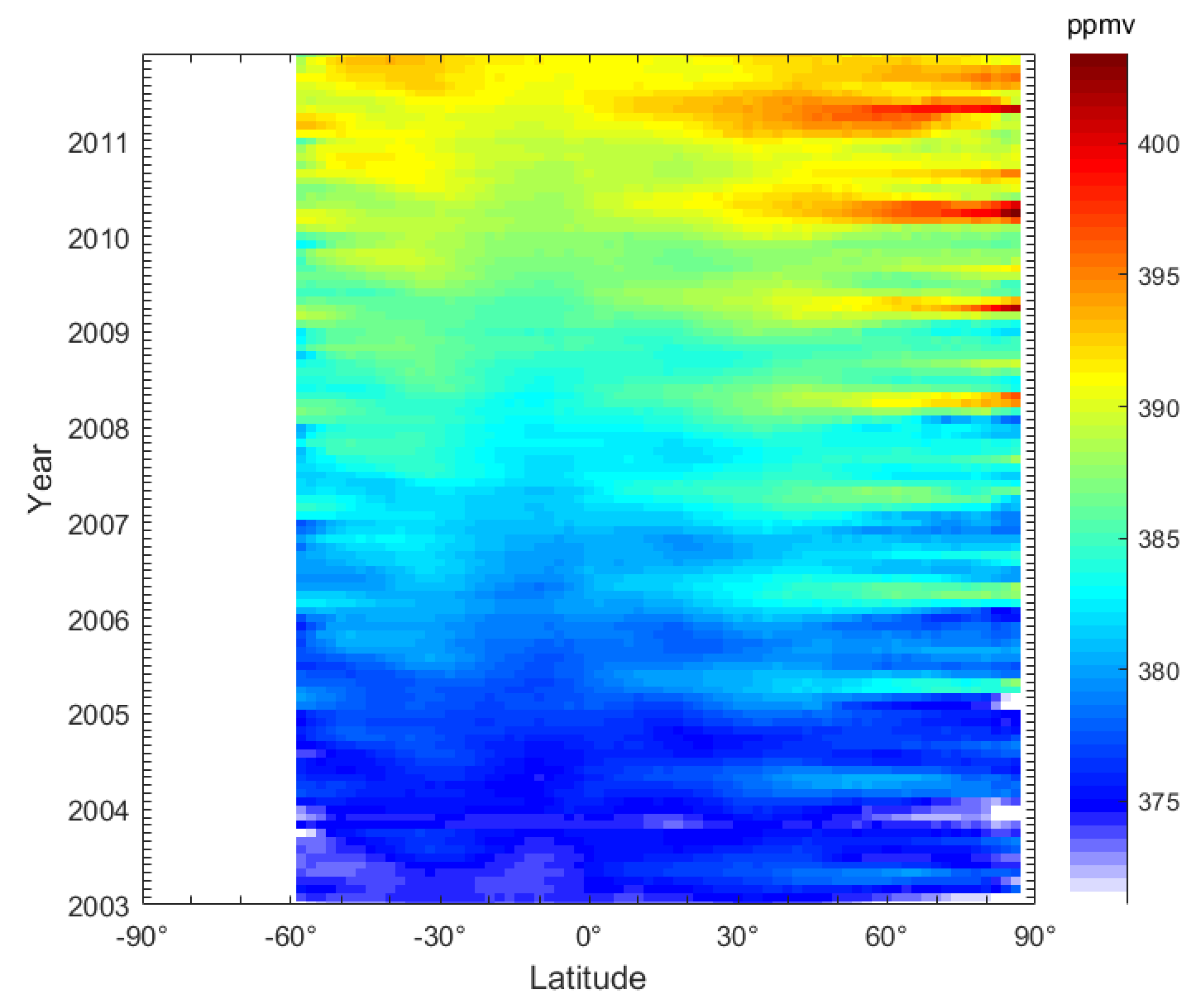
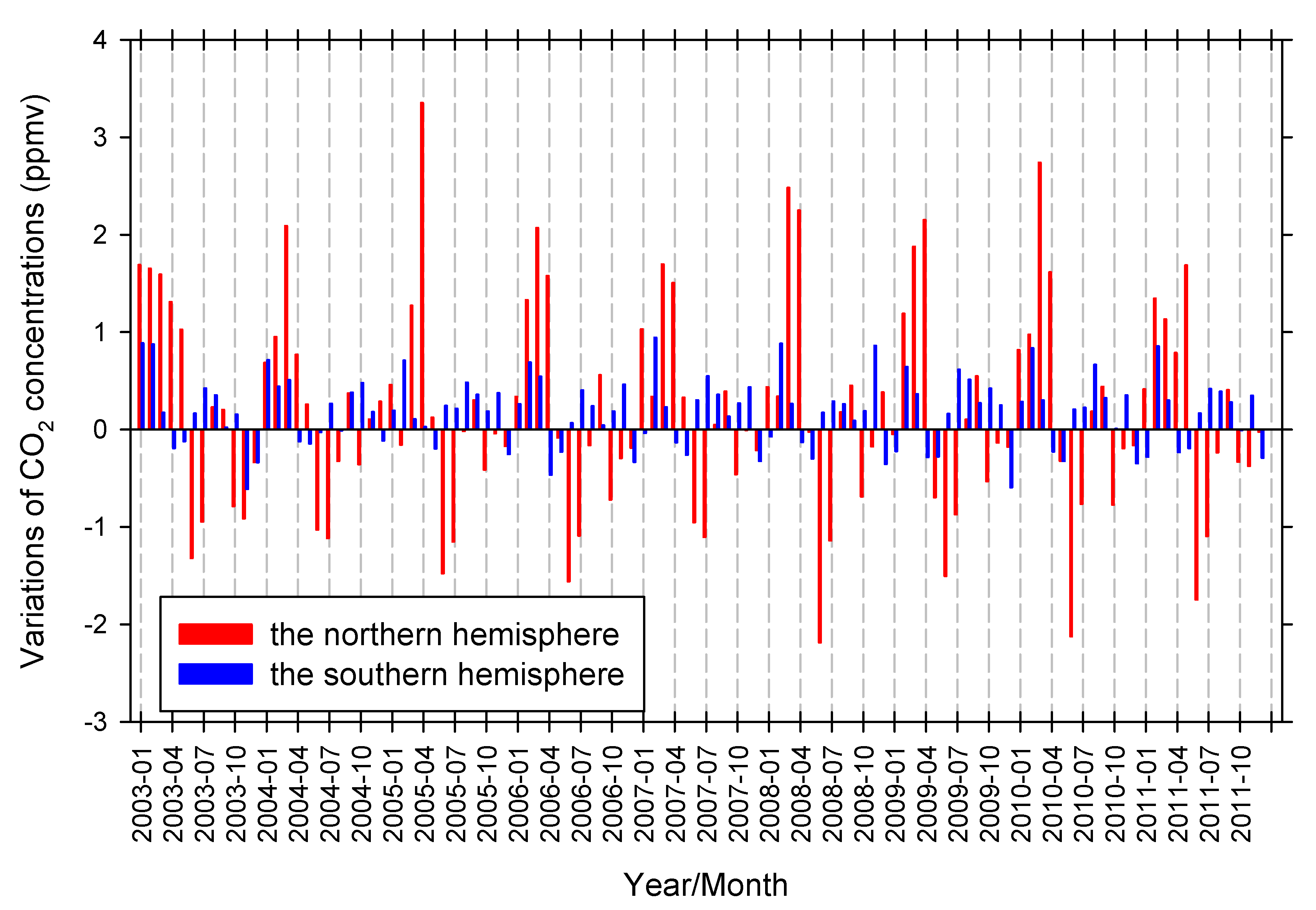
| Satellite | Instrument | Launched Year | Height Range | Spatial (km)/Temporal (Days) Resolution | Precision (ppm) | Accuracy (ppm) |
|---|---|---|---|---|---|---|
| Envisat | SCIAMACHY | 2002 | total column | 30 × 60/35 | 14 | 1.1–1.2 |
| Aqua | AIRS | 2002 | mid-tropospheric | 50 × 50/16 | 1.5 | 1–2 |
| MetOp | IASI | 2006 | mid-tropospheric | 12 × 12/72 | 2 | 2 |
| GOSAT | TANSO-FTS | 2009 | total column | 10.5 × 10.5/3 | 4 | 2.5 |
| OCO-2 | Three-channel imaging grating spectrometer | 2014 | total column | 1.29 × 2.25/16 | 1–2 | 0.5–1 |
| TanSat | ACGS | 2016 | total column | 2 × 2/16 | 1–4 | 2.11 |
| Observation Strategy | Data Sources | Spatial Location | Temporal Overlap | Accuracy | Articles |
|---|---|---|---|---|---|
| in situ aircraft | Matsueda (CONTRAL) | Between Japan and Australia | April–October 2003 | 0.9 ppmv | Crevoisier et al. (2004) |
| Western Pacific | September 2002–April 2004 | 0.43 ± 1.20 ppmv | Chaine et al. (2005) | ||
| Between Japan and Australia | 2003–2008 | Not given | Olsen et al. (2008) | ||
| Japan Indochina peninsula Southeastern Australia Narita airport | 2006–2011 | Not given | Lee et al. (2015) | ||
| NOAA ESEL/GMD | ±65° latitude | 2005 | 1.77 ppmv | Maddy et al. (2008) | |
| HIPPO | ±60° latitude | Not given | 1.46 ppmv | Christian et al. (2016) | |
| in situ surface | GAW (WMO WDCGG) | Assekrem (ASK) Mauna Loa (MLO) Niwot Ridge (NWR) Plateau Rosa Waliguan (WLG) | 2003–2010 | 2.298 ppmv | Zhang, Bai et al. (2010) |
| Mt. Waliguan (WLG) Crozet Island (CRZ) Mauna Loa (MLO) Assekrem (ASK) Tenefire (IZO) Niwot Ridge (NWR) | December 2003–November 2012 | r = 0.94 | Zhang, Zhang, et al. (2013) | ||
| 70 matched stations | Not given | RMSD = 5.88 | Zhang, Jiang, et al. (2015) | ||
| Southern Great Plains Point Arena Begur Pic du Midi Plateau Assy Puy de Dome Schauinsland | September 2008–December 2010 | Correlation coefficient = 0.27 | Diao et al. (2016) | ||
| Danum Valley | January 2009–June 2012 | Std = 1.82 ppmv | Othman et al. (2019) |
| TCCON Sites | Nationality | Latitude | Longitude | Reference |
|---|---|---|---|---|
| Lamont | America | 36.6°N | 97.4°W | [51] |
| Park Falls | America | 48.4°N | 2.3°E | [52] |
| Darwin | Australia | 12.4°S | 130.9°E | [53] |
| Ny Ålesund | Norway | 78.9°N | 11.9°E | [54] |
| Garmisch | Germany | 47.4°N | 11.0°E | [55] |
| Tsukuba | Japan | 36.0°N | 140.1°E | [56] |
| Izana | Tenerife | 48.4°N | 2.3°E | [57] |
| Bremen | Germany | 53.1°N | 8.8°E | [58] |
| Lauder 120HR | New Zealand | 47.4°S | 169.7°E | [59] |
| Wollongong | Australia | 34.4°S | 150.8°E | [60] |
| Instruments | Precision (ppmv) | Accuracy (ppmv) | |
|---|---|---|---|
| GAW | - | 0.1 | 0.1 |
| HIPPO | CO2_QCLS | 0.1 | 0.1 |
| CO2_AO2 | 0.3 | 0.1 | |
| CO2_OMS | 0.1 | 0.1 | |
| TCCON | Fourier Transform Spectrometers | 0.8 | 1 |
| TCCON Sites | Site Locations | Site Height | HIPPO Missions | HIPPO Instruments | HIPPO Profile | Overlapped Dates |
|---|---|---|---|---|---|---|
| Lamont (OC) | 36.6°N, 97.5°W | 0.32 km | 1 | AO2, OMS | 0.4–13.0 km | 30 January 2009 |
| 2 | AO2, OMS | 0.9–13.0 km | 20 October 2009 | |||
| 4 | AO2, OMS, QCLS | 0.5–8.6 km | 9 June 2011 | |||
| 5 | OMS, QCLS | 13.7 km | 11 August 2011 | |||
| Park Falls (PA) | 45.9°N, 90.3°W | 0.44 km | 2 | AO2, OMS | 0.6–11.0 km | 22 October 2009 |
| 5 | AO2, OMS, QCLS | 0.3–3.1 km | 9 August2011 | |||
| Darwin (DB) | 12.4°S, 130.9°E | 0.03 km | 4 | AO2, OMS, QCLS | 1.8–9.6 km | 4 July 2011 |
| Sites | Time Span (Months) | MAE (ppmv) | MSE (ppmv) | AVER (%) | R | |
|---|---|---|---|---|---|---|
| GAW | TCCON | |||||
| ZEP | NY | 60 | 2.302 | 2.998 | 0.597 | 0.967 |
| HPB | GM | 78 | 3.211 | 4.096 | 0.818 | 0.914 |
| KIS | TK | 45 | 6.723 | 1.599 | 1.684 | 0.856 |
| IZO | IZ | 68 | 0.959 | 0.957 | 0.245 | 0.974 |
| SGPs | OC | 65 | 4.296 | 5.216 | 1.084 | 0.806 |
| Mean | 63 | 3.498 | 2.973 | 0.886 | 0.903 | |
| TCCON Sites | Time Span (Months) | MAE (ppmv) | MSE (ppmv) | AVER (%) | R |
|---|---|---|---|---|---|
| NY | 46 | 2.977 | 3.699 | 0.773 | 0.718 |
| GM | 56 | 2.869 | 3.505 | 0.742 | 0.723 |
| IZ | 50 | 1.054 | 1.220 | 0.271 | 0.940 |
| OC | 43 | 1.9476 | 2.409 | 0.510 | 0.845 |
| BR | 82 | 2.789 | 3.608 | 0.725 | 0.769 |
| DB | 71 | 1.156 | 1.664 | 0.300 | 0.937 |
| LH | 79 | 1.421 | 1.709 | 0.371 | 0.958 |
| PA | 85 | 2.812 | 3.528 | 0.733 | 0.841 |
| WG | 45 | 1.540 | 1.699 | 0.397 | 0.927 |
| Mean | 62 | 2.066 | 2.560 | 0.538 | 0.851 |
Publisher’s Note: MDPI stays neutral with regard to jurisdictional claims in published maps and institutional affiliations. |
© 2020 by the authors. Licensee MDPI, Basel, Switzerland. This article is an open access article distributed under the terms and conditions of the Creative Commons Attribution (CC BY) license (http://creativecommons.org/licenses/by/4.0/).
Share and Cite
Yang, H.; Feng, G.; Xiang, R.; Xu, Y.; Qin, Y.; Li, S. Spatio-Temporal Validation of AIRS CO2 Observations Using GAW, HIPPO and TCCON. Remote Sens. 2020, 12, 3583. https://doi.org/10.3390/rs12213583
Yang H, Feng G, Xiang R, Xu Y, Qin Y, Li S. Spatio-Temporal Validation of AIRS CO2 Observations Using GAW, HIPPO and TCCON. Remote Sensing. 2020; 12(21):3583. https://doi.org/10.3390/rs12213583
Chicago/Turabian StyleYang, Hui, Gefei Feng, Ru Xiang, Yunjing Xu, Yong Qin, and Songnian Li. 2020. "Spatio-Temporal Validation of AIRS CO2 Observations Using GAW, HIPPO and TCCON" Remote Sensing 12, no. 21: 3583. https://doi.org/10.3390/rs12213583
APA StyleYang, H., Feng, G., Xiang, R., Xu, Y., Qin, Y., & Li, S. (2020). Spatio-Temporal Validation of AIRS CO2 Observations Using GAW, HIPPO and TCCON. Remote Sensing, 12(21), 3583. https://doi.org/10.3390/rs12213583







